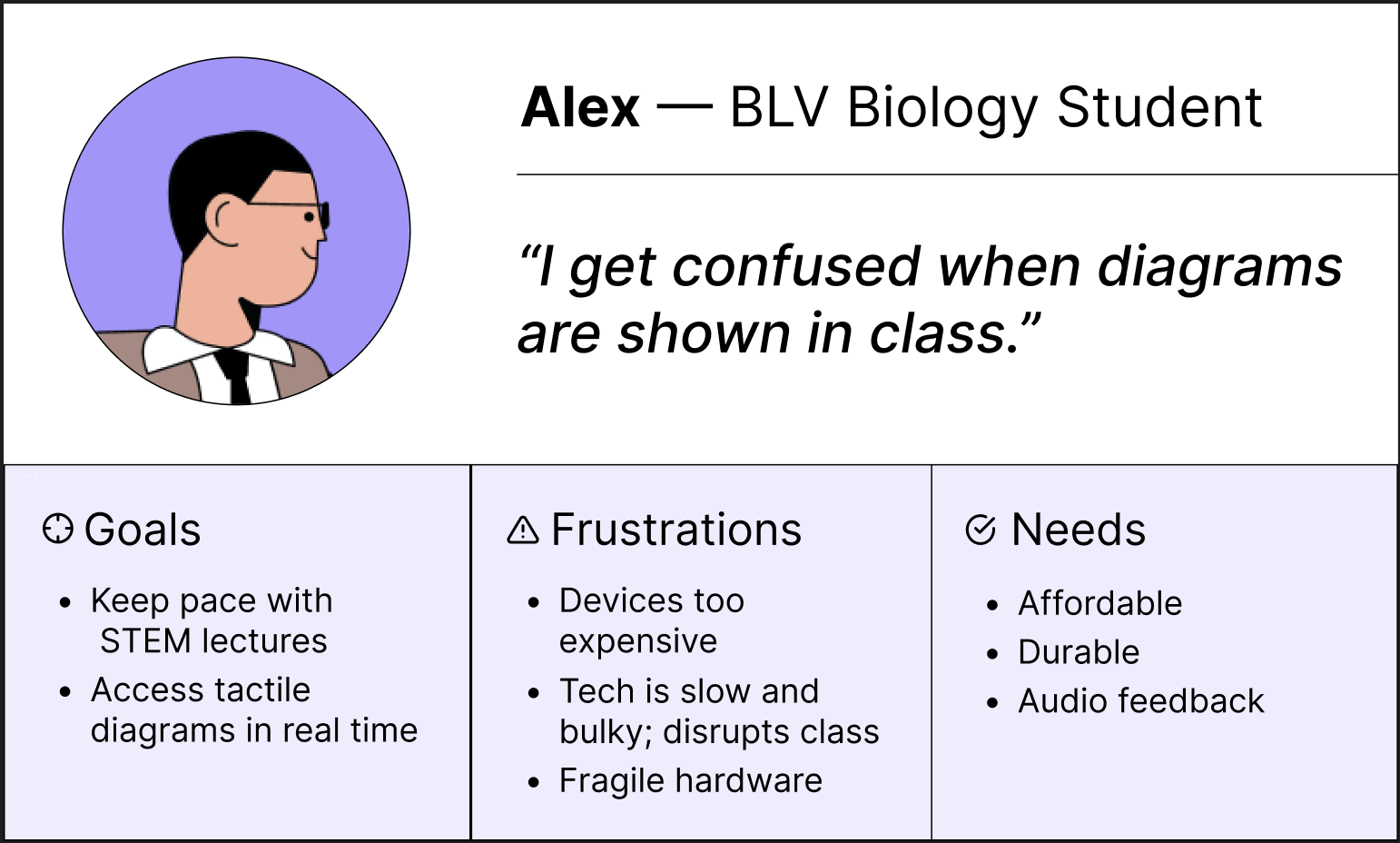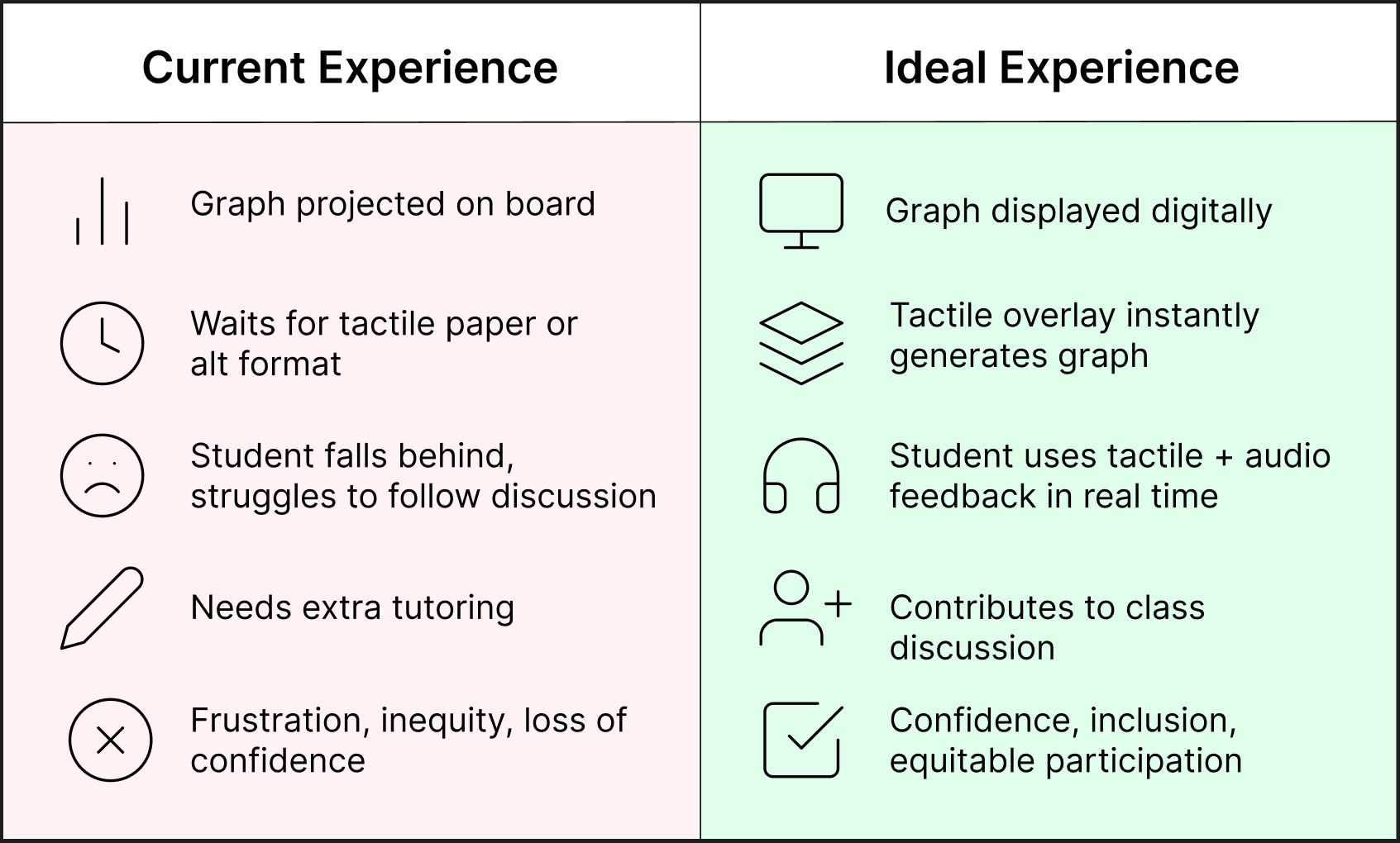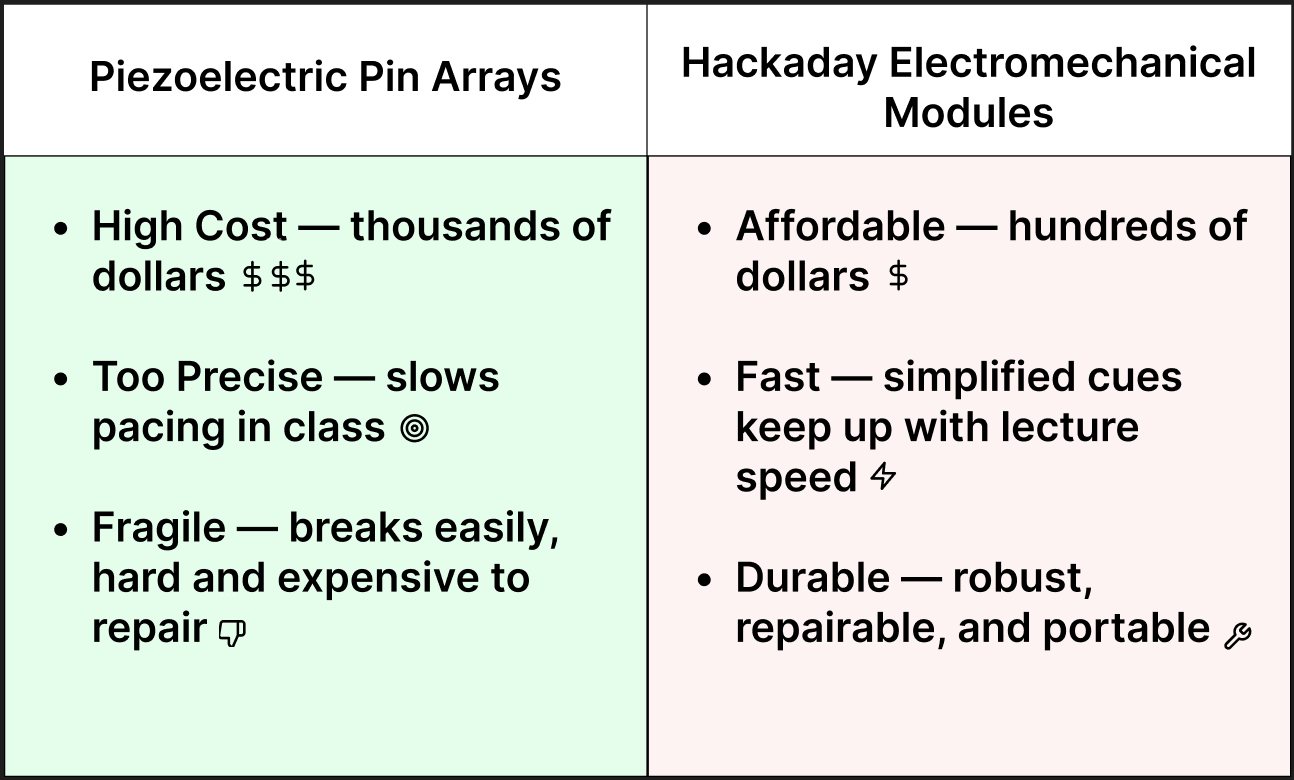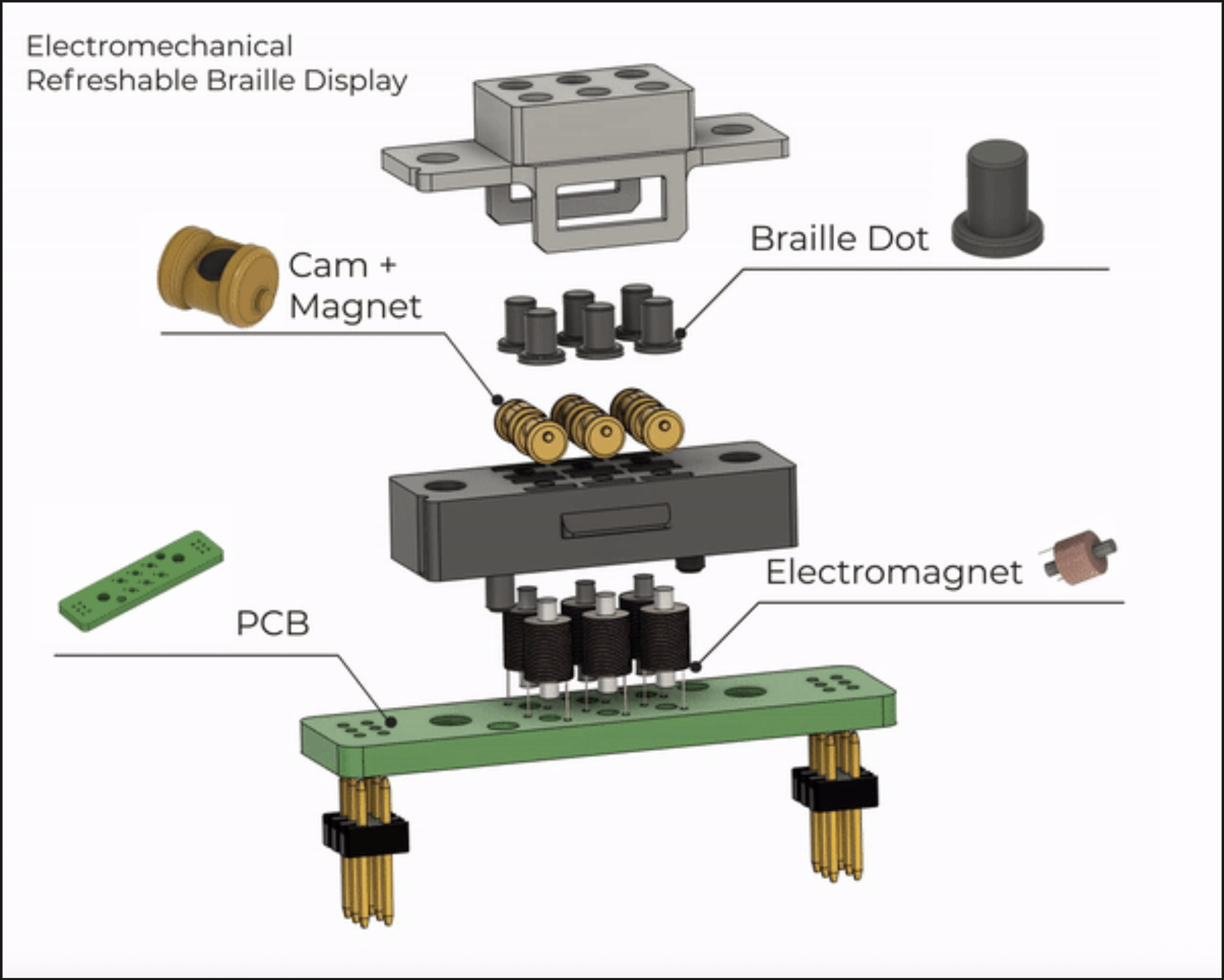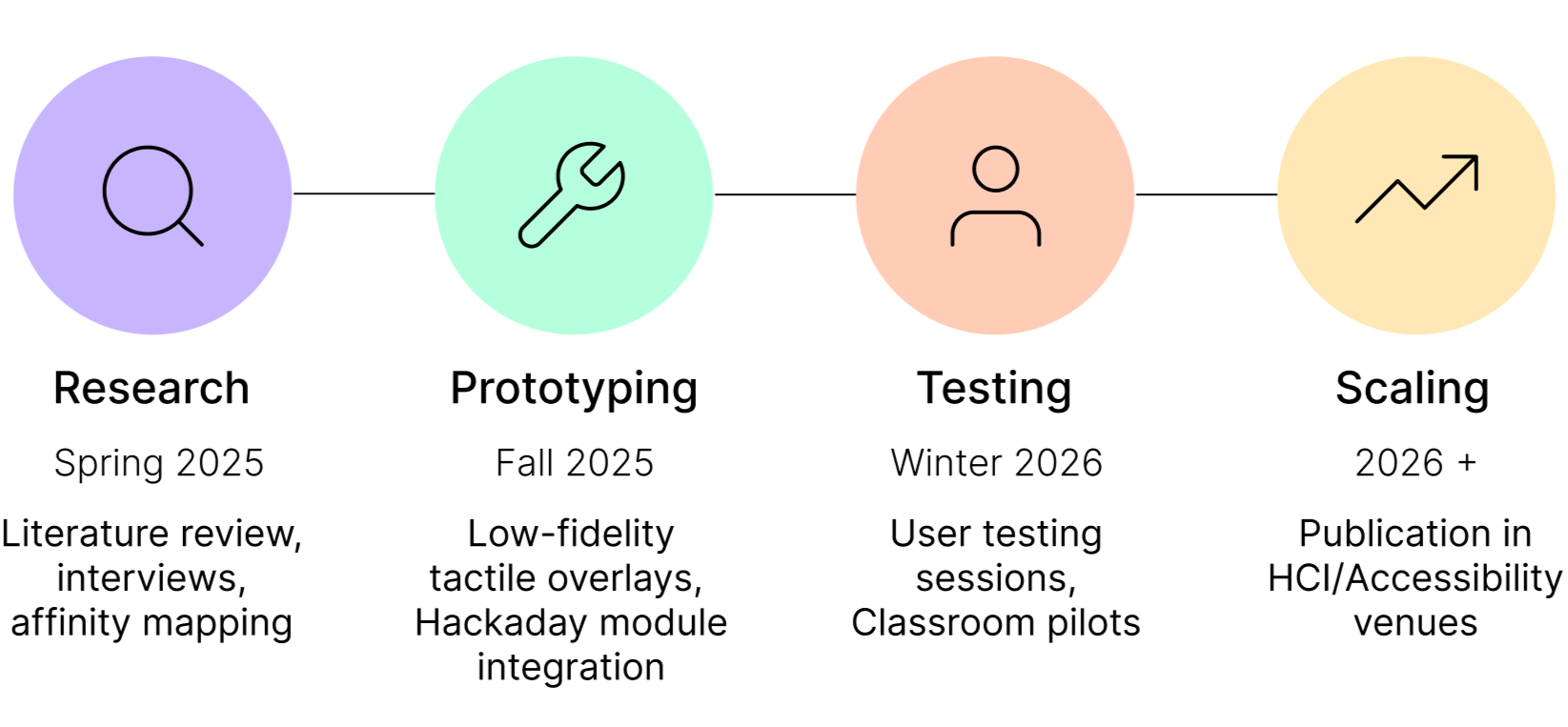
BLV TACTILE
INTERFACES
An ongoing research project exploring tactile interfaces for blind or low vision (BLV) students.

Overview
SUMMARY
I serve as a UX Researcher for a project addressing the inaccessibility of STEM classrooms for blind and low-vision students, turning user needs into actionable insights that guide engineering prototypes.
The result is a research backed direction toward affordable, durable, multimodal tactile interfaces using mechanical braille modules, shifting away from fragile, high-cost piezoelectric arrays.
ROLE
Spring 2025 | RESEARCH ASSISTANT
Summer - Present | UX RESEARCHER
Reviewed over 30 academic papers on tactile and multimodal accessibility.
Benchmarked existing devices (DotPad, BrailleNote, tactile overlays) through competitive analysis.
Designed and facilitated semi-structured interviews with assistive tech users.
Transcribed and analyzed interviews using thematic coding and affinity diagramming.
Synthesized findings into insights that informed engineering prototypes.
What is the Project?
CONTEXT
In STEM classrooms, blind and low-vision (BLV) students are often left behind when instructors introduce graphs, charts, or diagrams. Existing tools like braille displays are too costly, fragile, or slow to support real-time learning.
Our project aims to bridge this gap by studying BLV students’ needs and translating them into design solutions. Through academic research and user interviews, we’re guiding the creation of affordable, durable, and multimodal technology — built for inclusion in everyday classrooms.
Create a product that enables BLV students to follow along with graphs and diagrams in classrooms.
CHALLENGE
SOLUTION
Our project explores affordable, and multimodal solutions that translate digital graphs/diagrams into accessible formats for BLV students. By combining tactile overlays with audio feedback, the system makes it possible to follow classroom visuals in real time.
A tactile interface for real-time learning
Interview Design Protocol
CONSENT + ETHICS
Plain-language consent form
Remote-friendly sessions
Paid compensation for participants’ time.
OBJECTIVES
Understand assistive tech use
Identify challenges and successes
Confirm feature priorities & design criteria
EXAMPLE QUESTIONS
Could you tell us about your experience with braille displays?
What challenges do you face when accessing visual information?
Rank these characteristics: Affordability, Accuracy, Portability, etc.
Could you describe the ideal assistive tool?
Summary of User Research
LITERATURE REVIEW
Recurring challenges: high cost, limited portability, lack of multimodality.
Engineering novelty often diverges from user priorities
COMPETITIVE ANALYSIS
1. DotPad: High-resolution tactile display, but fragile and prohibitively expensive.
2. BrailleNote Touch Plus: Effective for text navigation, limited for diagrams.
3. Tactile overlays: Low-cost and accessible, but static and difficult to align with digital content.
INTERVIEWS
2 completed (5 target)
Designed for accessibility: plain language consent, optional audio recording, participant compensation.
Sessions (~30 minutes) focused on lived experiences with assistive tech, daily challenges, and thoughts regarding early ideas.
Research Insights
COMPETITIVE + ACEDMIC ANALYSIS: PAIN POINTS
Affordability: High device costs make adoption infeasible.
Portability: Bulky hardware was distracting and discouraged daily use.
Single-Modality: Multi-modal feedback is most effective
How might we balance affordability, speed, and portability in tactile interfaces while integrating audio feedback?
DESIGN QUESTION
INTERVIEWS: AFFINITY MAPPING
After transcribing and coding the interviews for recurring themes, affinity mapping revealed four non-negotiable priorities voiced across participants:
Key Insights Callout
Persona + User Journey
PERSONA
To ground the findings in lived experience, I developed a persona based on recurring themes.
Persona: Alex, a BLV biology student representing common goals, frustrations, and needs
USER JOURNEY
Mapping Alex’s classroom experience highlighted the gap between current tools and an ideal inclusive future.
User Journey Map: Current vs. Ideal classroom experience, showing how accessibility gaps create delays
Research Impact
Moved from piezoelectric pin arrays —> Hackaday electromechanical braille modules.
Committed to combing tactile + audio feedback
Focused on portability, repairability, and classroom viability.
Comparative Diagram: Piezoelectric vs. Hackaday modules
CAD render of Hackaday electromechanical braille module selected for prototyping
Reflection (Ongoing)
LEARNING
Learned to design accessible research protocols.
Strengthened skills in qualitative analysis.
Recognized balance between engineering and user needs.
Improved at translating user priorities into engineering constraints.
NEXT STEPS
Research: Conduct 3 more interviews
Prototyping:
Shift role from UX designer —> Product designer
Design prototypes with Hackaday modules
Test tactile + audio integration.
Usability testing with prototypes
Scaling: Apply for funding; publish results in accessibility and robotics venues.
TAKEAWAYS
Inclusive research requires designing the research process itself to be accessible.
User priorities (affordability, durability, usability) don’t always align with technical resolution.
Accessibility research is iterative and each cycle reveals new insights.
TIMELINE


